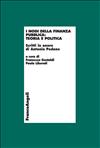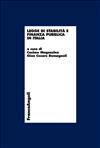Riduzione della spesa per interessi (1996-2003). Chi ne ha beneficiato? Una rappresentanza grafica (di Nicoletta Emiliani, Francesca Gastaldi, Giuseppe Pisauro, Giancarlo Salvemini) - ABSTRACT: Since 1996, interest payments on Italy’s public debt have significantly reduced as a consequence of public budget recovery, decrease in international interest rates and lower public debt/GDP ratio. This reduction may be viewed as a fiscal dividend. How was it used? How did it modify the public account structure? Which expenditure and tax items benefited most from this reduction? Did it cause some income redistribution? Using data on General Government accounts, the paper first analyses the distribution
of this fiscal dividend in terms of lower deficit, lower taxes and higher public expenditures (other than interest payments); to this regard, it also detects which expenditure areas have gained most for given levels of both deficit and taxes. Second, the paper investigates the distribution of expenses and revenues among the various levels of government (central, local and social security entities). Finally, the income redistribution
caused by the direct taxes reduction is analysed, by using a microsimulation model and focusing on personal income tax changes between 1996 and 2003. The main results are: a) the decrease in interest payments and public sector deficit is almost one-to-one; b) there is no evidence that any particular expenditure item has been targeted by this fiscal dividend; c) the reduction in primary surplus is mainly coming from an increasing deterioration of both local governments and social security accounts; d) there is some evidence that the income tax reductions at central level have generated some positive effects on redistributional grounds, even though they are partially compensated by corresponding increases in local income taxes.



